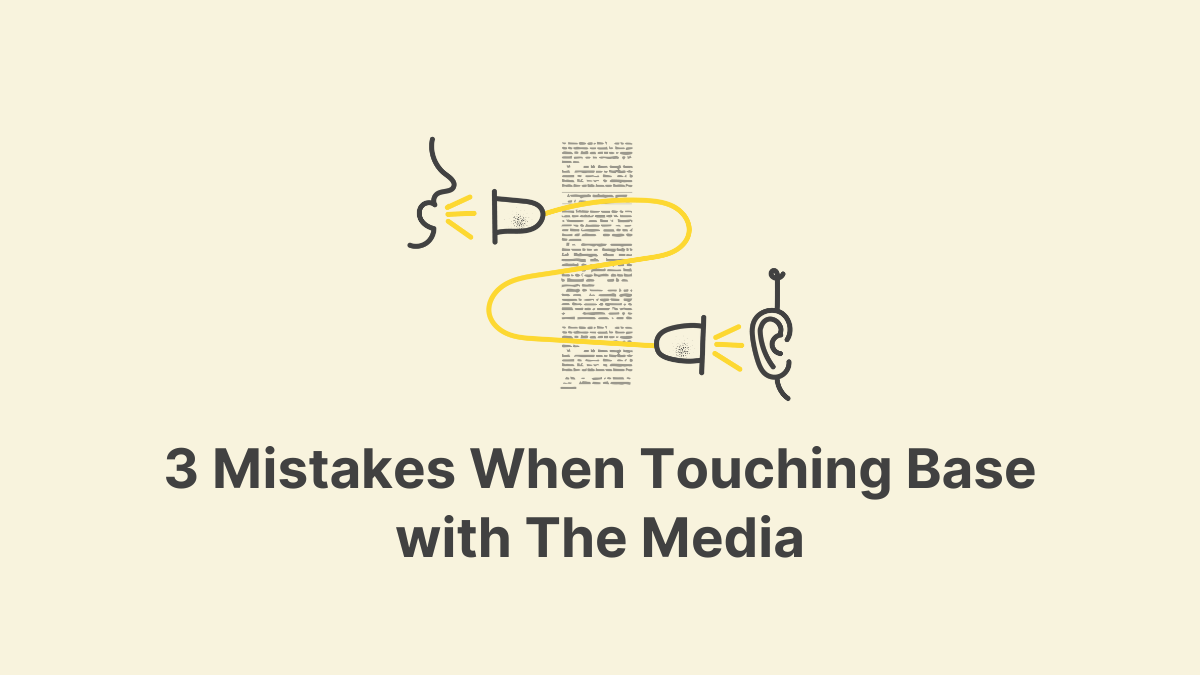3 Mistakes When Touching Base with The Media

In media relations and PR, relationship-building and communication are everything. Building strong relationships with the media is what distinguishes a great PR pro from an average one. Like with any relationship, it’s important to nurture it over time, and a big part of that is finding ways to keep in touch with your reporter contacts during times when you have hard news or a story and when you don’t.
Why touching base is important
Your relationships are your value. Investor Christina Farr argues that relationships are stronger than any carefully crafted media list.
One step further. Throw out media lists. A list is not a good starting point for building a relationship. Read instead, develop a familiarity and respect for reporting. Reach out when inspired by the work.
— Christina Farr (@chrissyfarr) October 3, 2023
Regularly touching base with reporters can keep you top-of-mind when a big story breaks. Bree Fowler, Senior Writer at CNET, often references previous pitches for future story needs.
“I also tend to sort things into – I have a huge filing system of folders in Outlook where I will save stuff for later. Like if somebody's pitching me about ransomware in schools. I'm not writing about that right now, but it doesn't mean it's a bad pitch and that I wouldn't want to talk to that person in a few weeks when a monster-size school district gets ransom. So I am a hoarder when it comes to email, but I'm a very organized hoarder.”
Touching base mistake #1: Treat journalists like they owe you something
While sometimes the journalist/PR pro relationship can feel a bit transactional, the best relationships don’t. The worst thing you can do is treat journalists like they owe you media coverage just because you pitched them.
Try this: Get personal
To create a connection that’s much more than a business arrangement, take the time to understand the reporter’s beat, what stories they’re writing lately, and what they're working on. Then, include those details in your communication with them. It shows them that you care about their work as a professional and will not waste their time, as Linds Bradshaw explains.
Kick off with something personalized. If I have previous rapport, I start there. I'm always sure to connect what I'm pitching to something their *currently* working on. As a PR pro, it's my job to know what's on their plate and offer any noteworthy sources.
— Linds Bradshaw (@imlindsbradshaw) January 19, 2023
Touching base mistake #2: The all-knowing source
When reaching back out to your media contacts with a new source or thought leader, do not send an introduction email without any details about what your source can speak about. This isn’t helpful for the journalist and doesn’t give them a clear sense of how your source can fit into their stories.
Today in PR pitches. 'Hi Margaret. I am writing to introduce you to Dr. (name mercifully redacted) who can provide expert commentary on any stories you are working on now or in the future.' … Versatile guy!!
— Margaret Sullivan (@Sulliview) September 19, 2023
Try this: Be descriptive
Instead, always include concrete details about which topics your source can speak to, their background, and experience, and make sure it’s a good match with your media contact’s beat and publication.
kind reminder to do your research and read what journalists write about before you pitch them https://t.co/jol2t70nir
— Jered Martin (@JmoMonk) August 18, 2023
Touching base mistake #3: Ignoring preferred communication methods
Everyone has different ways of doing things, including which channels and formats they prefer to receive pitches. Journalists often clearly list their preferences in their social media profiles, such as “no DMs, please” or “Email only.” The biggest mistake you can make is to ignore these preferences altogether. Sending a direct message to a journalist who states in their X profile that they do not accept DMs is a rude and careless way to ensure your pitch will not be answered.
Try this: Follow the rules
If a journalist identifies their preferred communication channel, use it. There are often specific reasons why they choose the means of communication that they do. The best thing you can do is be respectful and follow their preferences. Doing so shows that you respect them professionally and care enough to understand how they work.
Pay it forward
At the end of the day, media relationships are just like any other relationship — they take nurturing and mutual respect to last. One of the best things PR pros can do to help others in the industry is to make introductions and build connections. Introduce your PR colleagues with interesting clients to journalists you have strong relationships with. We all work together, not against each other.
When I know a fellow PR has a client that would be the perfect source for a story one of my journalist friends is working on, I always let them know. Love making these kinds of connections!
— Britt Klontz (@Britt_Klontz) May 9, 2023
______
To get more actionable tips from journalists, our Pitches That Placed series is a great resource for understanding how pitches turn into stories.
Want more blogs like this?
Fill out the form below to subscribe to our newsletter and receive emails with the top blogs from The TypeBar!
